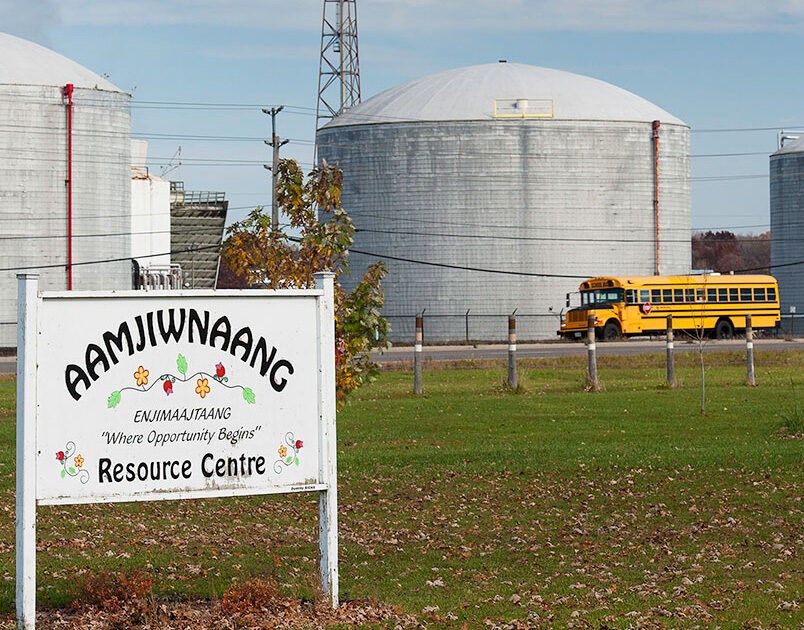Today, Aamjiwnaang First Nation is at Queen’s Park, Toronto to share a new path forward with the Ontario government to address toxic pollution and environmental racism that has been impacting their community for decades. Representatives from the Nation are holding a press conference in tandem with a rally attended by community members, frontline groups, and other allies.
Aamjiwnaang First Nation declared a state of emergency on April 25, 2024, when high air pollution concentrations of benzene, a cancer-causing chemical used and released by the nearby INEOS Styrolution plant, lead to illness and trips to the hospital for community members.
But this latest emergency is not an isolated incident for the community. Since an air quality monitor was installed near the INEOS facility in 2017, spikes of benzene were documented repeatedly. Aamjiwnaang First Nation is located near Sarnia, Ontario in an area known as Chemical Valley. Surrounded by dozens of oil refineries, petrochemical and chemical facilities, and power plants, the community has endured more than a century of environmental racism as industrial pollution has turned their land into one of Canada’s most polluted areas.
In addition to benzene, the community is subject to a myriad of harmful pollutants including sulphur dioxide, also known as SO2. SO2 is a harmful pollutant that can be released from acid gas flaring at oil refineries and emissions from chemical facilities. SO2 is linked to several respiratory issues and is especially dangerous to children and people with breathing and heart problems.
The toxic impacts on Aamjiwnaang are well documented. The pervasive nature of the problem is clear and cannot continue. The data is clear - it is time for action.
It’s only with a willingness to work in collaboration that the Province and Aamjiwnaang can collectively co-create the new path forward. Aamjiwnaang asserts their right to make decisions about the health, land, and well-being of their people, with free, prior, and informed consent. Aamjiwnaang is calling on the Ontario government to take concrete steps, in collaboration, to address the industrial harms threatening the health, culture, environment, and rights of the community.
Janelle Nahmabin, Chief of Aamjiwnaang First Nation, said:
“It’s time to step into the flow of change. The chains that have confined First Nations People from participating in our collective path are breaking. If you look, you will see. The path that Ontarians, Canadians and First People go down is a journey united by a common goal: to secure a healthier and promising future for the next generations. It’s been divided paths to get to where we are now but the road ahead can be a shared road. The choice is all of ours.”
Calling for action from the Ontario government
Solving the issues of environmental racism and toxic pollution requires the Ontario and Canadian governments to work together with Aamjiwnaang First Nation to find lasting solutions. Aamjiwnaang has an Inherent right to make decisions on issues that impact the wellbeing of their community, lands, and cultural practices. Decisions made by governments that impact these rights must involve free and prior informed consent.
There are concrete actions the Ontario government can take immediately to start remediating the injustices faced by the community. Aamjiwnaang is calling on the Ontario government to:
- Update Regulation 350, the Lambton Industrial Meteorological Alert (LIMA), to address the cumulative impacts and the harms and injustices of SO2 emissions.
- Take action on the problems identified by the Sarnia Area Environmental Health Project (SAEHP), which was led by the Ministry of the Environment, Conservation and Parks.
- Conduct necessary technical reviews to ensure the best available air pollution control is applied to key sources of pollution.
- Comprehensive follow up investigations are required to assess impacts of past contamination, including cumulative impacts.
- Review and assess the need for improved oversight of industry process safety management practices.
The Crown should work with Aamjiwnaang to follow up on recommendations from past health studies and continue to monitor diseases such as cancer. This would provide a picture of what really happened and is happening at the local and neighbourhood level from occupational and environmental exposures.
This story is shared from a media release provided by Ecojustice.ca
